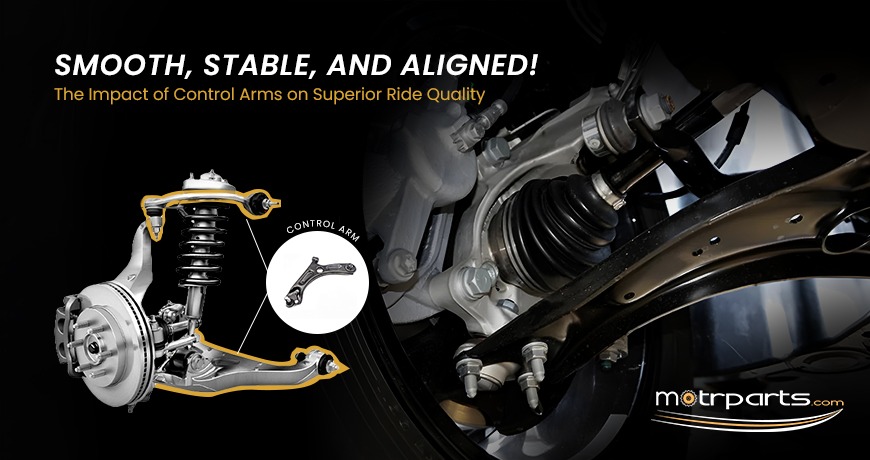When it comes to vehicle performance and ride quality, most people think about the engine, tires, or suspension. However, one of the unsung heroes that play a crucial role in how your car handles and rides is the control arm. Despite being a relatively small component, the control arm has a significant impact on your vehicle’s stability, handling, and overall comfort.
In this article, we’ll delve into what a control arm is, its function, and how it affects your ride quality. By understanding this critical component, you can better appreciate its role in your car and know when it might be time to seek a replacement, ensuring your vehicle remains safe and comfortable.
What Is a Control Arm?
The control arm, also known as an A-arm or wishbone, is a suspension component that connects the wheel hub to the vehicle’s frame. Typically made of steel or aluminum, it acts as a hinge that allows the wheel to move up and down while maintaining proper alignment. Most vehicles have two control arms per wheel—an upper and a lower control arm—although some vehicles only have one per wheel.
Function of the Control Arm
The primary function of the control arm is to manage the motion of the wheels. It keeps the wheels aligned with the body of the car and ensures that they move in harmony with the suspension system. By doing so, the control arm maintains the car’s stability and allows for smooth, controlled handling. Here are the key functions of a control arm:
- Stabilization: The control arm helps stabilize the vehicle by ensuring the wheels remain firmly in contact with the road, especially when driving over bumps or uneven surfaces.
- Wheel Alignment: Control arms keep the wheels properly aligned with the frame, which is essential for even tire wear and consistent handling.
- Shock Absorption: Working alongside the suspension system, control arms help absorb shocks from the road, contributing to a smoother ride.
How the Control Arm Impacts Ride Quality
The condition and functionality of your car’s control arms directly influence your ride quality in several ways:
1. Handling and Steering Response
One of the most noticeable ways a control arm impacts your ride quality is through handling and steering response. A well-functioning control arm allows for precise steering, ensuring that the vehicle responds accurately to your inputs. If a control arm is worn or damaged, you might experience loose or imprecise steering, making the car more difficult to control, particularly during cornering or at higher speeds.
2. Comfort and Smoothness
The control arm plays a vital role in smoothing out your ride by helping the suspension absorb shocks and bumps. If the control arm or its bushings (the rubber or polyurethane cushions that reduce vibration and noise) are worn out, you might feel more vibrations and jolts as you drive over rough terrain. This can significantly diminish the comfort of your ride, making it less enjoyable and more fatiguing over long distances.
3. Tire Wear
Improperly functioning control arms can lead to uneven tire wear. Since control arms keep the wheels aligned, any misalignment can cause the tires to wear out unevenly, reducing their lifespan and potentially leading to blowouts or other tire-related issues. This not only affects ride quality but also increases the cost of maintaining your vehicle due to more frequent tire replacements.
4. Noise and Vibrations
A damaged control arm can also lead to increased noise and vibrations. If the bushings or ball joints associated with the control arm are worn out, you might hear clunking or knocking sounds when driving over bumps or making sharp turns. These noises are not just annoying; they indicate that your control arms may need inspection or replacement to maintain the integrity of your vehicle’s suspension system.
Signs of a Failing Control Arm
Recognizing the signs of a failing control arm can help you address the issue before it significantly impacts your ride quality. Here are some common indicators:
- Clunking Noises: If you hear clunking or knocking sounds when driving over bumps, it could be a sign of a worn-out control arm or bushings.
- Vibrations: Excessive vibrations while driving, particularly when going over rough roads, may indicate that the control arm bushings are worn.
- Uneven Tire Wear: If you notice that your tires are wearing unevenly, it might be due to a misaligned control arm.
- Poor Steering Control: If your steering feels loose or less responsive, a faulty control arm could be the culprit.
Maintaining and Replacing Control Arm
Regular maintenance of your car’s suspension system, including the control arms, is essential for ensuring optimal ride quality. If you experience any of the signs mentioned above, it’s important to have your control arms inspected by a professional mechanic. In some cases, only the bushings or ball joints need replacement, but if the control arm itself is damaged, it will need to be replaced entirely.
At Motrparts.com, we offer a wide range of quality control arms and suspension components to keep your vehicle performing at its best. Whether you need a replacement part or an upgrade, we have the products and expertise to help you make the right choice.
Conclusion
The control arm is a crucial component of your vehicle’s suspension system, directly affecting handling, comfort, and safety. Understanding its role and the impact it has on your ride quality can help you maintain your vehicle properly and ensure a smooth, safe driving experience. If you suspect your control arms may be worn or damaged, don’t hesitate to seek professional advice and consider replacing them with quality parts from Motrparts.com to keep your car running smoothly.

